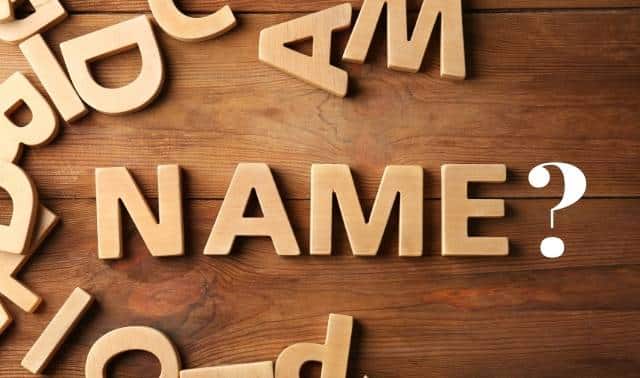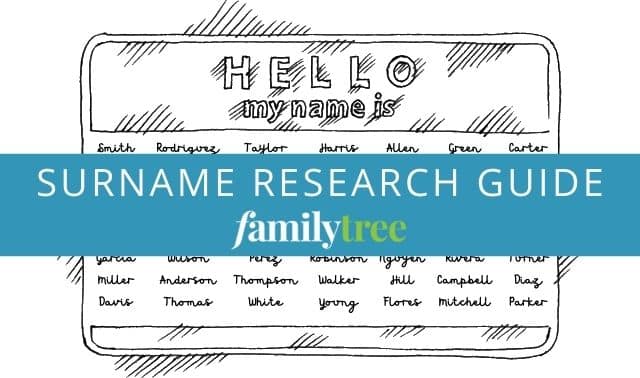Sign up for the Family Tree Newsletter Plus, you’ll receive our 10 Essential Genealogy Research Forms PDF as a special thank you!
Get Your Free Genealogy Forms
"*" indicates required fields
In her 1965 hit song, “The Name Game,” Shirley Ellis claimed she could make a rhyme out of anybody’s name. Clearly, she wasn’t a genealogist dealing with all the name variations and roadblocks we encounter in our research. We find nicknames, name translations, name changes, maiden names, naming patterns, name spelling variations, name abbreviations and two or more people of the same name. Yikes! And if you don’t type the name exactly as it’s entered in a computer database, you may never find your ancestor. Then there’s the other obstacle: What name do you record on your family charts? Let’s take a look at the most common name problems and how to solve them.
1. Incorrect spellings
Forget what your fourth-grade teacher said: In genealogy, spelling doesn’t count. You’ll find your ancestors’ names spelled all sorts of ways. Take your own name, first or last, and think of how many ways people have misspelled it. That’s what happened with your ancestors’ names. When clerks recorded your great-great-grandfather’s name on official documents, chances are they didn’t take the time to ask, “How do you spell that?” And that’s assuming your ancestor even knew how to spell his own name. In fact, you may find your ancestor’s name spelled two, three or four different ways within the same document.
Be careful not to wear blinders and miss your ancestor because his name isn’t spelled the way you think it should be. Yes, there are occasions when one branch of the family will change the spelling of its surname so as not to be associated with that other branch. But it’s more likely the clerk didn’t know your Smiths actually use the Smyth spelling.
Many researchers find it helpful to make a list of all the spelling variations of an ancestor’s name. Then, as they search in records and databases, they have the list to remind them to check under variant spellings. Take my surname, Carmack, for example. Spelling variations could include Cormack, Carmick, Cormick, Karmack, Kortnek, Karmick and Kormick.
Remember that printed and computerized indexes, databases, abstracts, transcriptions and sources such as city directories and newspapers also might contain typographical errors. If your ancestor’s name was the victim of a typo, such as transposed letters—Acrmack, Cramack or Carmcak—you have even more variations to check. You just have to pray to the genealogy spirits that the typist didn’t change letters or add new ones to your surname, making it Cammack or Carmach.
2. Nicknames
People new to genealogy often get thrown off by names they hadn’t considered to be nicknames for their ancestors. We’re accustomed to Ben being short for Benjamin, Liz or Beth for Elizabeth, and Bill or Will for William. But you might not realize that Polly was a common nickname for Mary prior to the 20th century. In fact, if you saw this nickname in your family records, you might think there’s an additional child or another wife in the family. Be on the lookout for Sally, too, which was a nickname for Sarah. A must-have guide to nicknames is Christine Rose’s Nicknames Fast and Present, 4th edition (Rose Family Association), which includes an appendix of Dutch/Frisian names along with their English equivalents.
3. Foreign names and spellings
Foreign names and spellings can be a real challenge. The name an immigrant ancestor used in America may not be the same one he used in his homeland. For instance, your Greek great-grandfather may have been known as Demetrius in the old country, but adopted the name James in America.
Sometimes, the foreign name is merely an English translation: Giuseppe Verdi becomes Joe Green. Or it may be a shortened version: Adamczyk to Adams. It also might be an Anglo name that sounds similar to the foreign one: Johann to John.
Just as you need to watch for nicknames when dealing with American ancestors, you also have to be on the lookout for foreign nicknames. Bridget, a common Irish name, has several nicknames, including Delia, Biddy and Cordelia. And while we’re on the subject of Irish names, keep in mind that you might find a Latin version of the name, Brigida, if the family was Catholic, as well as a Gaelic version, Brighid. Similarly, if you’re dealing with a Jewish ancestor, the name might have several versions: Hebrew, Yiddish, English adaptation, or even German, Polish or Russian renderings.
Many foreign surnames have prefixes, which may get dropped during assimilation in American society, and in indexes and databases. VanStockum may evolve simply into Stockum, O’reilly into Reilly. If you come up empty when searching for a name with a prefix, try looking for the name without it.
4. Name-change myths
A popular and commonly held belief in some families is that an ancestor’s name was changed on Ellis Island. But Ellis Island historians and genealogists haven’t found any documented cases of this happening. More than likely, immigrants’ names changed as part of the assimilation process. Maybe your ancestors wanted to become more American or avoid prejudices, so they changed their names themselves. My father shortened our Italian surname, DeBartolo, to Bart when I was born, so the family name would sound more “American.” Or perhaps your great-grandmother’s American teacher couldn’t pronounce her foreign name, so she gave the child an American equivalent.
Rarely will you find a legal name change. More often, the ancestor just assumed a new name. As long as he wasn’t doing it to be fraudulent, there was nothing wrong with adopting a new name. If you do suspect a legal name change, check court records in the county where your ancestor lived.
5. Maiden names
Researching female ancestors can be tricky because they typically were known by more than one surname in their lifetimes. A woman was born with one name (maiden name), and usually adopted her husband’s surname when she married. Some women may have multiple names if they married more than once.
Genealogists often have trouble identifying women’s maiden names, especially when they can’t locate marriage records. Emily Anne Croom, author of The Sleuth Book for Genealogists (Betterway Books), recommends using the “cluster genealogy” approach: Study the cluster of neighbors and relatives who associated with your female ancestor—that is, her husband, his associates (such as witnesses to documents), neighbors, children and basically anyone who came into contact with her or her family. One of them likely will be related to the woman in question.
6. Patronyms and necronyms
Historically, most cultures have had a prescribed pattern that couples used when naming their children. Many follow the typical pattern of naming the first son after the paternal grandfather, the first daughter after the paternal grandmother, the second son after the maternal grandfather, the second daughter after the maternal grandmother, the third son and daughter after the parents, and then subsequent children after aunts, uncles or other relatives.
In some cultures, such as Dutch and Scandinavian, people used a naming pattern called patronymics. The son’s surname was the father’s first name plus a suffix meaning “son of”—such as -sen or -son for Scandinavians and -se, -sen or -szen for the Dutch. So if your great-grandfather’s name was Eric Larsen, for example, his father’s first name would have been Lars, and his son’s last name would be Ericsen. Using the same pattern, girls’ last names ended in -datter (Scandinavian) and -x or -dr (Dutch). So Eric’s daughter would have the surname Ericsdatter.
When baptized, German children usually were given two names—the first being a spiritual name derived from a saint, and the second being a secular name. Often, the child would go by the second given name, especially if he and another sibling had the same first given name. So you could find three sons all with the first name Johann, but each was known by his middle name.
Some families used necronyms. According to this practice, couples would name a baby after a deceased child who had been named for a grandparent or other relative. Here’s an example from an Italian family:
- Chiara Stella DeBartolo (born July 1, 1887; died April 11, 1888)
- Albino DeBartolo (born Aug. 15, 1889; died Jan. 9, 1890)
- Chiara Stella DeBartolo (born March 7, 1891; died Aug. 12, 1891)
- Albino DeBartolo (born Oct. 30, 1892; died Nov. 19, 1894)
- Chiara Stella DeBartolo (born April 4, 1895)
- Albino DeBartolo (born Aug. 24, 1898)
- Margherita DeBartolo (born Sept. 3, 1901)
- Maria Giuseppa DeBartolo (born Jan. 21, 1906)
Francesco and Francesca (Regina) DeBartolo had eight children, but only four survived into adulthood. Notice the couple kept using the names Chiara Stella (after Francesco’s mother) and Albino (after Francesco’s father) until a child with that name survived.
7. Same names
One of the most difficult challenges in genealogy is identifying and keeping separate two men or women of the same name in a community. To avoid the pitfall of merging two or more people into one, certified genealogist Marsha Hoffman Rising, author of The Family Tree Problem Solver (Family Tree Books), always assumes at least two people of the same name lived in a given town. When you find several records for a Samuel Robberson, for example, it’s good habit to ask yourself, “How do I know these records (or events) pertain to the same man?” This constant questioning will help you refine your analytical skills.
Rising says land and tax records are the two most important documents for sorting out people of the same name. No two people own the same property; nor will they be taxed on the same things. And as far as recording a person’s name, land records are the most descriptive documents, Rising says. If there are two or more men in a community with the same name, land records usually include descriptive identifiers such as “John Williams the blacksmith”’ and “John Williams the wheelwright.” Or you may find the clerk used “junior” and “senior,” or “the younger” and “the elder.” Don’t assume, however, that these identifiers indicate a father-son relationship. They simply imply that one man was older than the other; the men might not be related at all.
Certified genealogist Patricia Law Hatcher, author of Locating Your Roots: Discover Your Ancestors Using Land Records (Betterway Books), also uses land and tax records to separate two people of the same name. She uses family reconstruction, as well. To do so, Hatcher collects every record she can find on an individual’s family. No two people with the same name will have the same parents, siblings or children. Putting a purported ancestor’s records and life events into chronological order (in a timeline, for example) can reveal that you’re dealing with two different people. If John Mabry died in 1850, and John Mabry is selling land in 1862, they can’t be the same person.
Because some names, such as Sarah/Sally and Mary/Polly, were so common, a man might have married two women with the same first name. The unwary family historian may assume her great-great-uncle Samuel had just one wife named Mary. But clues such as a large gap in the births of children or Mary’s having children in her 50s or 60s would suggest another wife entered the scene. To sort out two women with the same name, turn to land records. In these documents, says Rising, women were more likely to use their formal names than nicknames.
8. Truncated and superscripted names
As you search for your ancestors in original records and old indexes, you may run across truncated and superscripted names. For example, you may see Jas for James, Jno for Jonathan, Saml for Samuel, Thos for Thomas, and one that throws many researchers, Xr or Xer for Christopher.
Usually, you’ll see only abbreviated given names; however, I have seen some indexes that shorten a surname, such as Wmson for Williamson. If you use foreign indexes and records, be aware that clerks in other countries may have used similar abbreviations, such as these found in Italian civil-record indexes: Ma for Maria and Francofor Francesco.
9. Multiple names
You may find that your ancestor went by three or four names in a lifetime, especially if he or she was an immigrant. He may have been Salvatore DeMarco in the old country, Sal Marco in America, Sal Marcs in his official documents, and just Tore to family and friends. What name do you record on your charts? Professional genealogist Gordon L. Remington advises recording the name the ancestor was given at birth (or at baptism); then, in the notes section of your charts, record the other names you’ve found for the ancestor. Hatcher, on the other hand, uses slashes. Using the example above, she would write Salvatore DeMarco/Sal Marco/Sal Marcs/Tore Marco. Some genealogists prefer to put nicknames in quotes: Salvatore “Tore” DeMarco. But what’s crucial, says Remington, is not to translate a foreign name unless you find your ancestor used the translated name. Some immigrants continued to use their old-country names their entire lives.
In genealogy, a Rose by any other name is still a Rose, but you’ll find yourself playing the name game more often than you expect. Just when you think you’ve uncovered all the possible names for an ancestor, you’re sure to find another one. Make a list, then look for your ancestor under all the possibilities.
Versions of this article appeared in the December 2003 and January 2006 issues of Family Tree Magazine.
Related Reads
ADVERTISEMENT







